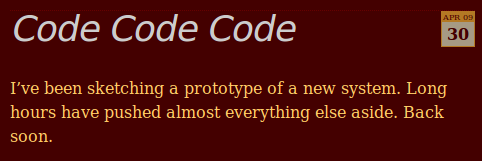May 15th, 2009
“The crux of the problem lies in the assumption that any program executing on a system on the user’s behalf should have the exact same abilities and permissions as any other program executing on behalf of the same user.”
OLPC wiki entry for bitfrost
Nice page on the security model built into sugar, the operating system for the OLPC. Explains security concepts well. Via Daringfireball.
Posted in ILT | Tags: platforms, security | Comments Off
May 14th, 2009
Download a metric units quiz. One side of A4 with a question where students match a measurement of an object (weight of new born baby, height of typical door) with the corresponding value (3Kg, 2 metres). Then the students have to find objects in the room that are various sizes. Finally some questions involving simple conversion. Designed to take 10 to 15 minutes.
I used the OpenOffice ‘note’ tool to add the answers to the quiz questions. Notes are annotations on the text that appear linked to a word or phrase on the right hand side of the document. You can make them invisible for printing a clean copy. The notes survived export to Word Doc format as well. In Word, you select View | Mark Up to ‘toggle’ the visibility of notes.

Posted in 20 minutes, Maths, Maths Quizzes | Tags: handout, Maths | Comments Off
May 13th, 2009
Click on Full Screen View on the slideshare.net player above (bottom right of the player, icon looks like a projector screen) to use on your interactive whiteboard.
Just one side of A4 on simplifying expressions, including collecting terms, multiplying terms, cancelling down algebraic fractions, and multiplying out brackets. Needs directed numbers. You can download a one side A4 handout on simplifying expressions as a PDF file saved from the OpenOffice Writer original.
You can see this handout at Scribd.com, but the embed code looks funny when I paste it into my blog, so its broken so far as I am concerned.
Posted in 20 minutes, Maths | Tags: algebra, Maths, one side guide | Comments Off
May 13th, 2009
“He and his unit had saved their sweet rations and were holding a Christmas party for local Berlin children. As he lifted a young boy on to a chair, he saw the child had only one arm. With a sickening flash he realised that only three years earlier the Allies had bombed the very people they were now trying to save.”
Dan Bell, BBC News
This puts moderators, marking, remission claims and all the other trivia in perspective. Back soon with tonnes of Maths screencasts.
Posted in Notes | Comments Off
May 10th, 2009
A University teacher called Cath Ellis posted her 10 Commandments of e-learning on a blog. Clive Shepherd (a free lance e-learning specialist working for companies) picked up on that post and put forward his 10 principles. Cath is working from a model of e-learning that is discussion based, Clive (deliberately) took a contrasting view based on presenting content.
The table below compares the two lists (my headings). Please read the originals, each commandment has a paragraph of context. Each post distils a lot of experience.
| People | Content |
| Cath Ellis | Clive Shepherd |
| Put the pedagogy (not the technology) first | Structure into modules. |
| Be aware of workloads and work patterns (yours and theirs) | Keep each module to one main idea |
| Balance risks with safety | Hook the learner in |
| Balance obligations with rewards | Build on the learner’s prior knowledge |
| Make ethics a priority | Present your idea clearly and simply |
| Model good practice | Eliminate all unnecessary detail |
| Make expectations clear | Put the idea into context using demonstrations, examples, cases and stories |
| Establish patterns and stick to them | Encourage the learner to work with the idea |
| Keep spaces available for students to use and shape to their own needs | Assess knowledge if you must |
| Use/develop protocols | Bridge to the next step |
.
I think I’ll be using a table like this (but with more of the context in each of the commandments) to explore models of e-learning in the Technology Supported Learning module next year. The two contrasting views make multiple connections with educational ‘theory’ but start from the role of the facilitator | author and the learners | participants.
Nice, thanks. I picked up on this when scanning Clive Shepherd’s ‘twits’. I’m assuming permission to reuse (in full, with attribution) because these are public blogs.
Posted in Learning | Tags: e-learning | Comments Off
May 8th, 2009
Posted in 20 minutes, Maths | Tags: handout, Maths, Number, numberacy | Comments Off
May 7th, 2009

Mark Bernstein is working on ‘a prototype of a new system’. That conjurers up images of sketchbooks, cafe tables with pots of coffee, and afternoon storm light.
I’ll need to stay with Mac OS just to see what it is. I was hoping to go totally open source this year. Tinderbox is one of the strongest reasons for not dumping Mac OS, and an important feature of Tinderbox is the ability to define prototypes, but it is apparent that Bernstein means new software here. We are talking about a company based on two products in something like 15 years?
I am wondering what happened to the Windows port of Tinderbox? Plus anyone who quotes David Mamet on the top of their blog is fine by me.
Posted in Notes | Comments Off

